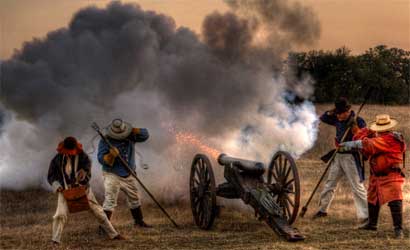
A THUMBNAIL SKETCH OF TEXAS HISTORY
By Bob Jamison
As we approach that fateful day in the history of this great state of Texas, there are many things we do remember. March 2nd is certainly one of those dates in l836. The Texas Declaration of Independence was signed. It declared that we will be independent of Mexico. The interim president would be David G. Burnet.
Four days after March 2nd, a fierce fight began. It was the Battle of the Alamo. It lasted thirteen horrible days in which a handful of now Texan heroes from Tennessee and elsewhere fought against tremendous odds. These remarkable men defied orders from General Sam Houston to retreat from the Alamo at once or die. A sword was drawn by William B. Travis who drew a line in the sand. He told them all of Houston’s orders but he would stay and fight for Texas’ honor. Any person that would care to join him may cross this line. Others would be free to leave without question. They crossed that line and all died; many were executed after the fall of the Alamo such as happened to Fannin and 400 other brave soldiers for Texas who were killed in the fight or later executed at Goliad only twenty five days after March 2nd.
Prior to those days between of l820 to l830, things were not so bad under Mexico. It was later the horror of war was rising on the western horizon. A notable event in Mexico was their independence from Spain in l82l. Two years later, Mexico granted permission to one Moses Austin to establish a community of 300 Anglo immigrant families to settle in the area which is now Brazoria County, Texas. Moses Austin died during this effort and his son, Stephen F. Austin (the famed Father of Texas) took over in this undertaking.
However, seven years after l823, Mexico had a change of heart for Texas. It closed its borders to all Anglo-Americans! Now isn’t that a twist compared to today’s times? Trouble started brewing in Anahuac, Texas. Juan Bradburn, half American and half Mexican, was ordered by Mexico to establish a fort to collect taxes and control immigration. But there was a real thorn in Bradburn’s antagonist side. It was none other that William B. Travis, a lawyer from (now) Liberty, Texas. His law partner was Patrick Jack. Bradburn was harboring escaped slaves from Louisiana. Travis and Jack represented the slave owners and they wound up in jail in Anahuac.
Texans didn’t like that at all and a real rumble began around Turtle Bayou in l832. The Brazoria patriots decided to bring some big guns to help. A Mexican fort at Velasco, Texas on the mouth of the Brazos, fired shots and the Battle of Velasco (now called Surfside, Texas) took place June 26, l832. The first casualties of the War of Independence happened right there. The Texans won that three day fight and captured the fort. For good reasons Travis was released.
The next year a General in the Mexican Army was elected president of Mexico. His name was Santa Anna. Things really started picking up under his command. The Texas diplomat, Stephen F. Austin traveled the long road to Mexico City to negotiate peace with Mexico. Instead he landed in jail. Finally after his release he was instrumental in the Declaration of War against Mexico in l835.
Since the Declaration of Texas Independence March 2, l836, about four years after the Battle of Velasco, Mexican troops stormed across Texas leaving much bloodshed along the way. General Houston retreated ahead, much to the dismay of his faithful followers, but they did have a brief skirmish at Morgan’s Point just south of (now) Baytown. It was a test of strength. Houston fell back further to Lynchburg on Buffalo Bayou on April 20, l836. The next day in the early afternoon, Houston’s riflemen sneaked through tall grass to within musket range of Mexican soldiers snoozing around stacked rifles.
Then the booming sounds of the “Twin Sisters”, each a cannon delivering explosive into the midst of the Mexican army announced the Battle of San Jacinto. It lasted twenty seven minutes. Santa was captured and brought to Houston’s pallet where he was lying wounded. After much discussion and debate, many have written that the conclusion by Houston was that defeated Mexico most needed a strong leader. In part, Houston said to Santa Anna “I give you Mexico and you give me Texas.”
Ironically, where the first casualties happened four years earlier at Velasco, the Treaty of Velasco was signed as a covenant between Texas and Mexico. Much was certainly not lived up to by either side. Instead, Santa Anna was locked in chains and ultimately sent to Washington, D.C. to appear before the President of the United States, Andrew Jackson. Hopefully, this was intended to cease the Mexican-American problems. Then Santa Anna was transported to Veracruze, Mexico by the U. S. Navy, as promised in the Treaty of Velasco.
Anahuac has certainly been an important part in the clash between Texas and Mexico. The fort trace lies in the general area of the riverside park just south of the town. In l938 the Chambers County surveyor made field notes of the location of the fort and the surrounding area though it was then in private hands. Those documents are surely available until this day. However, in l946 Chambers County acquired the site and ordered the debris cleared and buried. A few amateur excavations have occurred but substantive study has never been made.